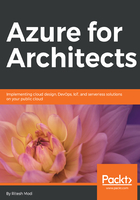
上QQ阅读APP看书,第一时间看更新
Azure Resource Manager features
The following are some of the major features provided by Azure Resource Manager:
- Role-Based Access Control: Azure Active Directory (AAD) authenticates users to provide access to subscriptions, resource groups, and resources. ARM implements OAuth and RBAC within the platform, enabling authorization and access control to resources, resource groups, and subscriptions based on roles assigned to a user or group. A permission defines access to operations on a resource. These permissions could allow or deny access to the resource. A role definition is a collection of these permissions. Roles map AAD users and groups to the permissions. Roles are subsequently assigned to a scope, which can be an individual, collection of resources, resource group, or subscription. The AAD identities (users, groups, and service principles) added to a role gain access to the resource according to permissions defined in the role. ARM provides multiple out-of-the-box roles. It provides system roles, such as owner, contributor, reader, and more. It also provides resource-based roles, such as SQL DB contributor, virtual machine contributor, and more. ARM allows the creation of custom roles.
- Tags: Tags are name-value pairs that add additional information and metadata to resources. Both resources and resource groups can be tagged with multiple tags. Tags help in the categorization of resources for better discoverability and manageability. Resources can be quickly searched and identified easily. Billing and cost information can be fetched for resources that have the same tags applied. While this feature is provided by the ARM, an IT administrator defines its usage and taxonomy with regard to resources and resource groups. Taxonomy and tags, for example, can be defined based on departments, resource usage, location, projects, or any other criteria deemed fit from a cost, usage, billing, and search perspective. These tags can then be applied to resources. Tags defined at the resource group level are not inherited by its resources.
- Policies: Another security feature provided by ARM are policies. Custom policies can be created to control access to the resources. Policies are defined conventions and rules and must be adhered to while interacting with resources and resource groups. The policy definition contains an explicit denial of actions on resources or access to resources. By default, every access is allowed if it is not mentioned in the policy definition. These policy definitions are assigned to resource, resource group, and subscriptions scope. It is important to note that these policies are not replacements or substitutes for RBAC. In fact, they complement and work together with RBAC. Policies are evaluated after a user is authenticated by AAD and authorized by the RBAC service. ARM provides JSON-based policy definition language for defining policies. Some of the examples of policy definition are that it must tag every provisioned resource or resources can only be provisioned to specific Azure regions.
- Locks: Subscriptions, resource groups, and resources can be locked to prevent accidental deletion and updates by an authenticated user. Locks applied at higher levels flow downstream to child resources. Locks applied at subscription level lock every resource group and resources within it.
- Multi-region: Azure provides multiple regions for the provisioning and hosting of resources. ARM allows resources to be provisioned at different locations and yet reside within the same resource group. A resource group can contain resources from different regions.
- Idempotent: This feature ensures predictability, standardization, and consistency in resource deployment by ensuring that every deployment will result in the same state of resources and their configuration no matter the number of times it is executed.
- Extensible: ARM architecture provides an extensible architecture to allow creation and plugging of newer resource providers and resource types into the platform.